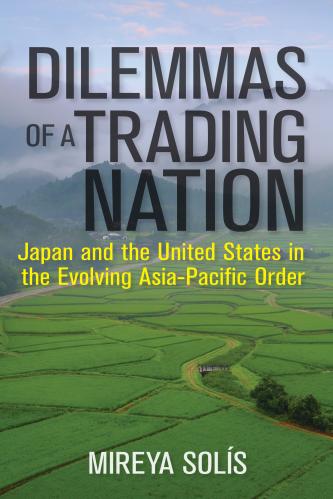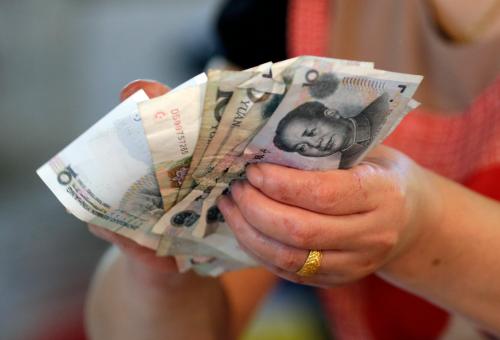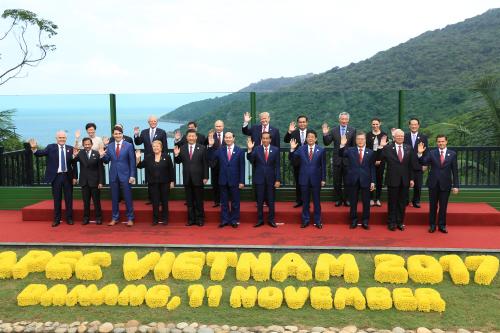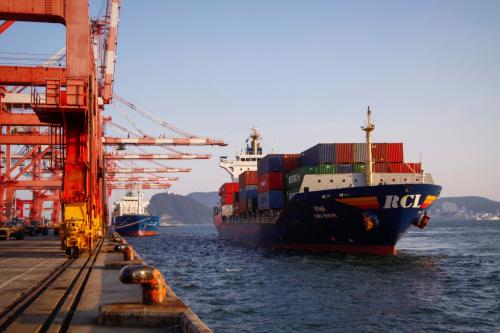The Trump administration is moving toward scoring an “own goal” on the American economy with its current trade strategy in Asia. Just as when one scores a goal for an opponent in soccer, an “own goal” in international trade occurs when a country takes actions that harm itself and advantage its competitors.
The focus of the Trump administration’s trade agenda in Asia has been on negotiating bilateral free trade agreements, securing greater balance in trade with China, and renegotiating the U.S.-Republic of Korea (KORUS) free trade agreement. So far, the record is negative and trending worse.
Bilateral Free Trade Agreements
Trump entered office promising to deliver bilateral trade agreements that would improve upon the 12-nation Trans-Pacific Partnership (TPP). He has been unable to deliver on such pledges for at least five reasons. First, Trump’s withdrawal from the TPP and his stated desire to pull out of the KORUS agreement and the North American Free Trade Agreement (NAFTA) highlighted the fickleness of his fidelity to existing agreements, even with America’s closest allies. Second, Trump adopted a maximalist, uncompromising, take-it-or-leave-it-approach to renegotiating NAFTA and KORUS, which is having a chilling effect on any country considering entering into trade negotiations with Washington. Third, Trump failed to appreciate the integrated nature of value chains in Asia, which have diminished the significance of bilateral free trade agreements. Fourth, Trump has suggested he wants to use trade agreements to eliminate bilateral trade deficits, as opposed to focusing on market access. This misguided approach ignores that a trade balance equals the difference between savings and investment. As a consequence, potential negotiating partners are deterred, knowing they will have a target on their back for any FTA that does not deliver balanced trade. And fifth, Trump underestimated that our Asian trading partners have other options (i.e., with China, the remaining 11 members of TPP, and with Europe).
The net effect of Trump’s “America first” trade policy is that many of America’s closest trading partners in Asia are accelerating efforts to advance regional economic integration while the United States stands on the sidelines.
China
On China, the record to date has been troubling. In announcing tariffs on imported solar cells and modules last month, the Trump administration protected a small number of U.S.-based solar manufacturers, one of which is Chinese-owned, at the expense of destroying roughly 23,000 American solar workers’ jobs. The move also appears to have triggered Chinese retaliation against American sorghum producers, a geographically concentrated group in the Midwest that exports 79 percent of its product to the Chinese market. Protecting a Chinese-owned company at the expense of American workers’ jobs is the epitome of an own goal.
Trump’s next major China trade-related decision is whether to use national security as a basis to protect America’s steel and aluminum industry. The national security rationale for such a finding are so thin that reportedly even Secretary of Defense Mattis has reservations about this course of action. So, too, does every living former chair of the Council of Economic Advisors, Republicans and Democrats alike. They argue in a joint letter to President Trump that previous attempts to use protection to revitalize the steel industry have failed, and that by imposing steel tariffs now, Trump would harm the U.S. economy by raising input costs for manufacturers, reducing employment in manufacturing, and increasing prices for consumers.
On top of that, no matter how carefully the protections are crafted, tariffs would do disproportionate harm to our most important diplomatic partners from whom we import the majority of our steel—such as Canada, Mexico, Germany, the Republic of Korea, and Vietnam—and not China, from whom we import very little steel.
The costs of alienating our partners will become clear when the White House turns around and asks them for their support (or non-opposition) to U.S. use of unilateral trade tools to press China to remove discriminatory policies. The president appears set on using Section 301 of the Trade Act of 1974 to unilaterally seek remedies for unfair Chinese trade practices. The risks of such a gambit are multifaceted. First, such a move will almost certainly spark Chinese retaliation, which in turn will risk setting off a tit-for-tat trade war. Second, such a unilateral action will blow a hole through the existing international trading system that other countries will likely follow. This, in turn, risks unraveling the current international trade dispute resolution mechanism. And third, without the backing of our European and Asian partners, there is a higher probability they will backfill U.S. companies in China during a trade war. Just think of Airbus planes instead of Boeing planes, and Australian beef in place of American beef exports. This, too, would be an own goal.
Korea
Then there is Korea. Trump has launched an assault on KORUS—the economic underpinning of the Washington-Seoul relationship—at a time when the alliance is under unprecedented strain due to North Korea’s nuclear and missile programs. Trump’s attempts to compel Seoul to capitulate to his trade demands have drained goodwill without deriving a single benefit for any U.S. exporter.
Don’t get left behind
While each of these efforts is misguided, doing nothing is not a viable option. The Asia-Pacific region is moving forward with its own economic integration, with or without America’s involvement. The United States should seek to harness regional integration initiatives to establish high standards for trade and investment liberalization that leverage America’s comparative advantages. The goals would be at least twofold: first, to expand export opportunities for America’s most dynamic sectors; and second, to show the region that the United States is ready to strike mutually beneficial deals to bring about alternative economic integration options to ever-deepening dependence on China.
Ultimately, the objective of U.S. efforts in Asia should be to foster an open, integrated economic structure where U.S. firms can compete fairly against companies from throughout the region. By setting an affirmative vision and then building regional support for it, the United States would improve its ability to create a level playing field for American businesses, manufacturers, farmers, fishermen, and ranchers to compete.
President Trump already has shown flickers of support for such a strategy. He expressed openness at Davos to future U.S. involvement in the Trans-Pacific Partnership. Now is the time for President Trump’s advisors and members of Congress to nurture and encourage those instincts, as 25 senators recently did in a letter to the president. Delivering a region-wide trade deal that sets high standards and supports American workers would be an outcome worthy of the ambition of a president determined to chart a new course.







Commentary
Time to rethink U.S. trade strategy in Asia
February 20, 2018